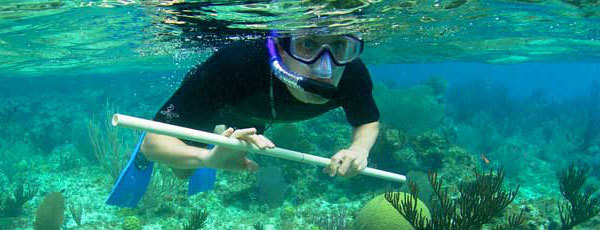Bahamian Reef Survey
- San Salvador, Bahamas
- Volunteer Vacations

| Contact provider for price | 8 Days | Year-round |
| Simple accommodations | Exertion level: 4 | |
| Operator: Earthwatch Institute | 20 people max | |
Scientist John Rollino has the longest-running experiment and data set on coral reefs in the world, with more than 17 years worth of information. While efforts to improve our understanding of the threats to reefs must continue, in recent years Dr Rollino and his colleagues have also increased their emphasis on testing methods that might allow reefs to recover, from performing underwater “repairs” on some reefs to providing others with artificial materials that might save their underlying struture.
Loading map, please wait...
Locations visited/nearby
Bahamas
0 testimonials about this trip.
1 testimonial about the provider, Earthwatch Institute:
-
Reviewer: L. Reifschneider
located in
St. Louis,
MO
USA
Elephant conservation is what drives my travel destinations. However, I always come home counting the blessings of new friends and an understanding of a culture and way of life I possibly would otherwise have never been introduced to. Through the Earthwatch projects I participate in, I am learning just how big and wonderful this world is.
Special information
- This is a custom departure, meaning this trip is offered on dates that you arrange privately with the provider. Additionally, you need to form your own private group for this trip. The itinerary and price here is just a sample. Contact the provider for detailed pricing, minimum group size, and scheduling information. For most providers, the larger the group you are traveling with, the lower the per-person cost will be.
Itinerary
Snorkel through the crystal clear waters around a remote Bahamian island to survey endangered coral reefs, document the threats to their health, and help test techniques that might restore them.You'll learn to conduct a number of ecological field measurements: surveying hard corals and other reef animals and plants, mapping transect sites and taking reef measurements, and testing water chemistry. On land, you'll map corals in tidal pools and monitor beach profile data for changes. You’ll also help refine methods for repairing and even rebuilding reefs that have been damaged by bleaching, storms, run-off, and systemic threats such as global warming. In the evenings, you'll transcribe the day's data, and enjoy films and lectures.
Longtime Earthwatch scientist John Rollino continually receives high marks for his patience, humor, and teaching prowess. In your recreational time, you can scuba dive, go caving, see where Columbus first set foot in the New World, nature hike, or just enjoy the beautiful surroundings.
You’ll sleep in shared rooms at the comfortable Gerace Research Center (GRC), a former U.S. Navy base. The rooms are former officers’ quarters and each has a fan, a sink, an adjoining shared bathroom, and showers. The GRC cooks will provide simple, filling meals in their cafeteria. Teams will also have a meal or two out at a local restaurant and finish the expedition with a slice of guava duff (cake) - a volunteer favorite!
San Salvador Island in the Bahamas is surrounded by warm, blue waters full of beautiful subtropical reefs, as is perhaps most well know as the place that Christopher Columbus made his first landfall in this hemisphere in 1492. The island’s interior is mostly uninhabited and full of hypersaline lakes. San Salvador is one of the outermost links in the chain of some 700 islands sprinkled throughout more than 5,000 square miles. While similar to the other islands of this archipelago, it is unique for its history, ecology, inland lakes, and the pressure to develop it mostly undeveloped landscapes.
The harbor remains largely as Columbus saw, except for the Gerace Research Center, which is located on the berm of a beach composed of calcareous sands. Pleistocene sand dunes, sea cliffs, and other unique coastal features can be found within walking distance of the Center.
More information from Earthwatch Institute:
- View trip on provider's website
earthwatch.org/expeditions… - Company profile, experience, and history
- View all of their trips
- Email this trip page to a friend
-



Comments from Facebook